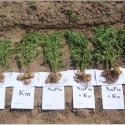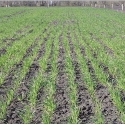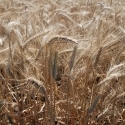25 Mar 2014
Planning Winter Wheat Yields Based on the Environment and Nutrient Management
Alexander N. Esaulko and Elena A. Ustimenko
Setting crop yield goals comprises an understanding of a complex set of interrelated measures. Timely and precise consideration of these measures helps both the achieve-ment of goals for crops yield and quality as well as goals for long-term soil fertility and environmental protection (Esaulko et al., 2013). The goal of crop yield planning is to determine the site-specif c yield potential for each crop or variety (Esaulko and Ustimenko, 2012). These data could be obtained through fertilizer response trials in the f eld; however, crop character-istics obtained in variety trials can also be used (Esaulko et al., 2012; Ustimenko, 2013).
Field experiments at the Stavropol State Agrarian Univer-sity (SSAU) Research Farm were conducted during 2010-2012 adopting existing regional approaches to setting winter wheat yield goals. Winter wheat variety “Zustrich” was selected, which is a medium maturity (vegetation period 273 to 282 days), medium height variety with good lodging resistance characterized by high environmental plasticity, drought and frost tolerance. It is also a high gluten, high protein variety (i.e., gluten 27 to 28%, protein 12.0 to 13.5%).
Field experiments were conducted on a deep-leached chernozem (Luvic Chernozem) of clay loam texture. Soil pH was close to neutral (average pHKCl = 6.7), soil OM was medium (5.1 to 5.6%), and the soil had medium levels of available P (average 22 ppm P2O5) and K (240 to 260 ppm K2O) extracted with 1% (NH4)2CO3 solution. Winter wheat was preceded in the crop rotation by f eld pea. Field experiments were con-ducted within a RCB design with three replications. Whole plot size and harvest area were 40 m2 (10 m × 4 m) and 22 m2, respectively.
Weather conditions during three experimental years were characterized by nonuniform distribution of precipitation (Table 1). Annual precipitation was below the long-term average with the exception of the 2009-2010 agricultural year. Experimental years had elevated temperatures with an annual temperature 1.1 to 1.4°C above the long-term average. The most favorable weather conditions for winter wheat growth and development were observed in 2010-2011. Total precipitation during August, 2010 to July, 2011 was 7% below the long-term average; however, its uniform distribution contributed to opti-mal water supply to plants and hence the highest grain produc-tion. The average air temperature was found to be 10.6°C in 2010-2011, which exceeded the long-term average by 1.4°C. Extremely unfavorable weather conditions were observed in 2011-2012. Nonuniform distribution of rainfall during spring-summer 2012 negatively affected winter wheat production.
Nutrient Rate Calculations
Two methods were used to calculate nutrient rates based on winter wheat grain yield goals of 4.0, 5.0 and 6.0 t/ha. Ac-cording to the 1st approach developed by SSAU (Ageev and Podkolzin, 2006), P and K rates were calculated as follows:
Nutrient rate (P2O5 and K2O rate, kg/ha) = 100,
where:
R = nutrient removal in wheat grain plus straw (P2O5 and K2O, kg/ha) at the planned yield goal;
Кs = coeff cient showing P and K recovery from soil re-serves by wheat crop at the planned yield goal depending on available P and K levels in the soil (0.47 to 0.66 for P and 0.58 to 0.70 for K);
Кf = coeff cient showing apparent crop recovery eff ciency of applied nutrient (40% and 70% for P and K, respectively).Nitrogen rates were calculated using the following updated formula: N rate (kg/ha) = (R(N) - R (P2O5)*Ks(P2O5)*K)*100 / Kf,
where:
К = N removal in wheat grain plus straw/P2O5 removal in wheat grain plus straw at the planned yield goal; Кf = coeff cient showing apparent crop recovery eff ciency of applied N (70%).The 2nd approach was developed by researchers from Stavropol Research Institute of Agriculture and Stavropol State Centre for Agrochemical Service.
Nutrient rates were calculated as follows (Petrova et al., 1987):
Nutrient rate (N, P2O5, and K2O, kg/ha) =YRКc, where:
Y = winter wheat yield goal, t/ha;
R = nutrient (N, P2O5, and K2O) removal in wheat grain plus straw, kg/t grain;
Кc = coeff cient showing nutrient use to removal for wheat grain plus straw (0.49 to 0.52 for N, 1.10 to 1.36 for P, and 0.30 to 0.43 for K depending on the planned yield goal).
Moreover, a zero fertilizer treatment (control) and recom-mended blanket rates for the agro-ecological zone (N60P60K30) were also included into the experimental scheme. Fertilizer applications included basal rates of K applied as KCl before tillage and P fertilizer as MAP at planting. Nitrogen fertilizer was topdressed in early spring as ammonium nitrate.
Results
Three-year averages for yield components of winter wheat are presented in Table 2. Results indicate that number of productive tillers (NPT) varied most widely compared to other growth param-eters depending upon the level of plant nutrition. NPT improved from 373 to 432 tillers/m2 due to increas-ing fertilizer use. Different fertilizer combinations increased NPT by 21 to 59 tillers/m2 compared to the non-fertilized control. The highest values (431 to 432 tillers/m2) were obtained in treatments receiving N126P80K72 and N110P82K51 nutrient rates for the highest yield goal of 6.0 t/ha.
Number of kernels per spike also increased due to fertilizer application and the difference with the control reached 2 to 7 kernels/spike. The highest number of 30 kernels/spike was formed in the treatment receiving N110P82K51. Kernel weight per spike also increased through all fertilizer treatments except the recommended blanket rates (N60P60K30). The difference with control varied from 1 to 9% depending on fertilizer rates. Similar to the number of kernels the highest kernel weight per spike (1.07 g) was obtained in the treatment receiving N110P82K51. Fertilizer combinations positively affected 1,000 kernel weight. Recom-mended blanket rates (N60P60K30) had the lowest effect on the above-mentioned parameter resulting in only 4% increase compared to 6 to 10% in other fertilizer treatments. The heaviest kernels (37.5 g per 1,000 kernels) were formed with the fertilizer combination of N110P82K51.
Fertilizers significantly increased winter wheat grain yield in our study because of considerable im-provement of the yield components. Grain yield increase over the control ranged from 0.76 to 2.80 t/ha in 2009-2010, from 1.03 to 2.90 t/ha in 2010-2011, and from 0.97 to 2.28 t/ha in 2011-2012 depending upon the fertilizer combination (Table 3). Hence, plant nutrition with N, P and K is highly important for winter wheat production on leached chernozems of the region resulting in yield increases of up to 87 to 93%.
Optimization of winter wheat nutrition based on a yield goal of 4.0 t/ha indicates that both methods for calculating nutrient rates allow for quite precise yield planning. A higher grain yield of 4.17 t/ha (three-year average) was obtained in the treat-ment receiving N68P44K24 (i.e., when we used the 2nd method for calculating nutrient rates). Recommended blanket rates (N60P60K30) gave a similar yield of 4.16 t/ha. The 1st method for determining nutrient rates resulted in lower productivity of 3.90 t/ha (N60P34K34).
Both methods for calculating nutrient rates were also quite reliable when we set a yield goal of 5.0 t/ha. There was a small difference from the average attainable yield that was slightly lower than this planned yield goal. Marginally better yield planning was observed when we used the 1st approach and got an average yield of 4.73 t/ha (N105P60K60).
However, we revealed considerable differences between attainable yield and the highest yield goal of 6.0 t/ha. The 1st approach to determining nutrient rates allowed an average grain yield of 5.60 t/ha (N126P80K72). Grain yield was lower with the 2nd method (N110P82K51) and averaged 5.36 t/ha giving an 11% difference from the yield goal. Nevertheless, we didn’t reveal signif cant differences between the above-mentioned treatments. It is important to indicate that attainable yield was much closer to the yield goal of 6.0 t/ha in the year 2010-2011, which had the most favorable weather conditions.
Experimental plots of winter wheat during 2009 season (4th December).
The improvement of winter wheat grain quality has ex-ceptional importance in the region. Data shown in Table 3 indicate that all nutrient combinations resulted in higher gluten content in grain (by 5.2 to 9.9%) compared to control. The highest gluten content (26.3 to 27.0%) was obtained in treat-ments receiving high fertilizer rates (N126P80K72 and N110P82K51). Fertilizer application also contributed to high gluten quality as indicated by the Gluten Deformation Index (GDI). GDI ranged from 72 to 75 units in fertilizer treatments. Signif cant improvements of grain protein content by 2.0 to 2.2% were obtained only at high fertilizer rates (N126P80K72 and N110P82K51).
Recommended nutrient combinations for the yield goal of 6.0 t/ha were the most prof table in our study. The Return on Investment (ROI) for these two treatments receiving N110P82K51 and N126P80K72 was as high as 125% and 131%, respectively (Table 4).
Summary
Optimization of plant nutrition with N, P and K is very important in improving both yield and quality of winter wheat grown on leached chernozems in Southern Russia. Both meth-ods for calculating nutrient rates attained the planned yield goal of 4.0 t/ha. Yield goals of 5.0 t/ha and 6.0 t/ha were not attained taking into consideration the average winter wheat production for three years. More precise yield planning could be achieved when nutrient rates are calculated using the 1st method developed by SSAU.
Dr. Esaulko is Professor, Department of Agrochemistry and Plant Physiology, e-mail: aesaulko@yandex.ru.
Ms. Ustimenko is third year postgraduate student, Department of Agrochemistry and Plant Physiology, e-mail: ustimenko_elena_26@mail.ru. Stavropol State Agrarian University, Stavropol. The authors acknowledge
Dr. V. Nosov, Director, IPNI Southern and Eastern Russia Region, for his comments and help during the preparation of this article.
References
Ageev, V.V. and A.I. Podkolzin. 2006. Agrochemistry (South Russian aspect): Textbook for higher education students. Vol. 2 (V.V. Ageev ed.). Stavropol, Stavropol State Agrarian University. 480 p. (In Russian).
Esaulko, A.N., E.V. Golosnoy, A.Yu. Fursova, E.A. Ustimenko, T.S. Aisanov, and A.F. Dontsov. 2013. In Use of modern and innovative resource conservation technologies in the agroindustrial complex. pp. 5-8. (In Russian).
Esaulko, A.N. and E.A. Ustimenko. 2012. Innovations in Science, 15: 103-107. (In Russian).
Esaulko, A.N., E.A. Ustimenko, and A.Yu. Gurueva. 2012. In Proceedings SWorld on International Conference. Vol. 46. No 4. pp. 95-98. (In Russian).
Petrova, L.N., A.Ya. Chernov, E.P. Shustikova, A.I. Podkolzin, L.G. Karandashov, and A.V. Bulavinov. 1987. Methodical guide on calculating mineral fertilizer needs and bulk fertilizer distribution among collective and state farms in Stavropol Krai. Stavropol. 20 p. (In Russian).
Ustimenko, E.A. 2013. In Young scientists of North Caucasus Federal District for the agroindustrial complex of the region and Russia. pp. 41-43.




